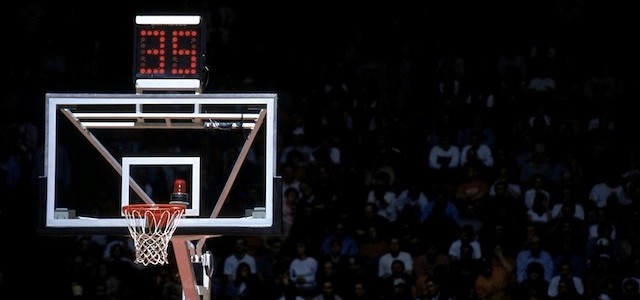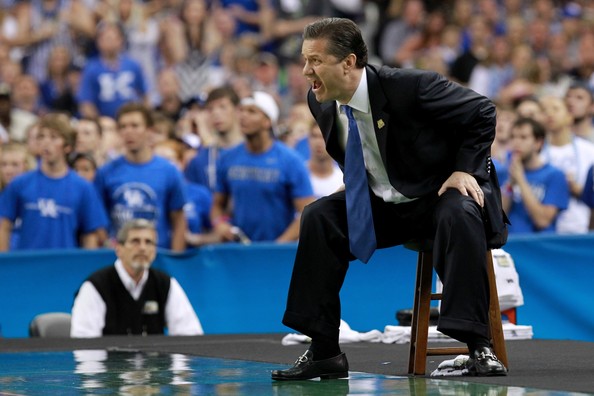Some big changes are on the way for the upcoming NCAA college basketball season. No, the NCAA’s not going to begin compensating its unpaid laborers. Maybe some other time. Instead, it has made these significant rule changes with the intent of improving certain aspects of on-court product which have seen a bit of decline in recent years.
Among the more notable rule changes are the reduction of the shot clock from 35 seconds to 30, the number of timeouts and timeout protocols, and the moving of the restricted arc from three feet to four feet.
So how exactly will these changes affect the college game once they’re implemented? Read on as we breakdown the new rules, and while you’re at it enjoy the last moments of the NBA season with our preview of Cavaliers-Warriors.
[sc:MultiSportArticles ]Five Ways the New Rules Will Change NCAA Basketball
More scoring opportunities
The most significant and widely talked about rule change of the bunch is the reduction of the shot clock from 35 seconds down to 30. The change is in large part a response to the game’s continuously declining scoring numbers.
[sc:NCAAB240banner ]According to KenPom.com, the go-to website for advanced college basketball stats, the average pace of play in 2013 was 65.9 possessions per 40 minutes, the slowest it had ever been. And after a brief spike up to 71 points per game last season from 67.5 in 2013, scoring once again plummeted to 67.1 points in 2015, the biggest one-season drop in history.
Basic math dictates that the less time teams have the ball per possession, the more possessions and scoring opportunities they can have throughout the course of the game. However, it’s still unclear whether this change gets to the actual heart of the problem why teams score fewer points these days.
For all we know, this change could just result in teams shooting even more bricks. But if more offense – good or bad – is what people want, then that is what they’ll get. And by sheer law of averages, this change should result in a couple more points per game next season.
Quicker offensive sets
Another offshoot of the reduced shot clock is that offenses will have to get moving a lot faster. Anyone who’s watched college basketball for the past few years has most likely sat through some excruciatingly long possessions wherein an offense would waste clock with a couple of aimless dribbles or passes before actually running their offensive sets deeper into the shot clock.
The reduced shot clock will definitely help cut these useless parts of the games out, which would be a welcome development for the viewing audience. The watchability quotient of these games should in turn go up a point or two simply by reducing five seconds of inertia and procrastination from each possession.
Fewer timeouts
Speaking of watchability, the constant stoppages in college basketball – particularly during the last few minutes of the second half – definitely take their toll on the overall quality of the product.
Micro-managing college coaches are a big part of the problem, but since the NCAA can’t exactly legislate for a specific kind of coaching, the changes to reduce the number of timeouts – from five to four, and not more than three in the second half – and the elimination of the coach-called timeout during a live ball are the next best thing.
These changes to timeouts – which also include the elimination of timeouts called within 30 seconds of TV timeouts – should do wonders to keep the game flowing and to keep the length of the game to a much more acceptable time.
Fewer collisions, fewer charge/block fouls
Another factor which has caused the constant stoppages is the amount of fouls being committed inside the paint. With the restricted arc in college just three feet away, help defenders would just get beyond the arc – a simple task given the relatively short distance – and settle for taking a charge. Whether it’s a charge or a block, a foul is getting called either way when a collision takes place.
But with the arc now being moved to four feet out, players should find getting outside the restricted area a bit more challenging. This, in turn, should lead to fewer collisions, fewer fouls, and fewer stoppages.
More exciting finishes
And last but not least, the changes with the timeouts could also have a significant effect on how teams decide to play during end game situations, especially in games that are going down the wire. Taking away even one timeout is huge; coaches won’t be able to stop the clock and set their offense/defense for an extra possession, which could be crucial in very close games.
And since the ability to call live-ball timeouts has also been taken out of the coach’s hands, players are now empowered to make key decisions late in games. So instead of calling a timeout and drawing up a play in a close game, we could now see teams just go for the more exciting option of going for it in transition before the defense gets set.
Hopefully, more teams do take the more exciting option, especially because not all college players will be able to handle it. We’ll see a bevy of thrilling transition points, and a handful of players simply imploding under the pressure and misplaying it entirely. Both options are more fun than an extra timeout.
Create a betting account now and pick the right sportsbook option for all your college basketball wagering needs.
[sc:NCAAB490Banner ]1,755 total views, 2 views today









